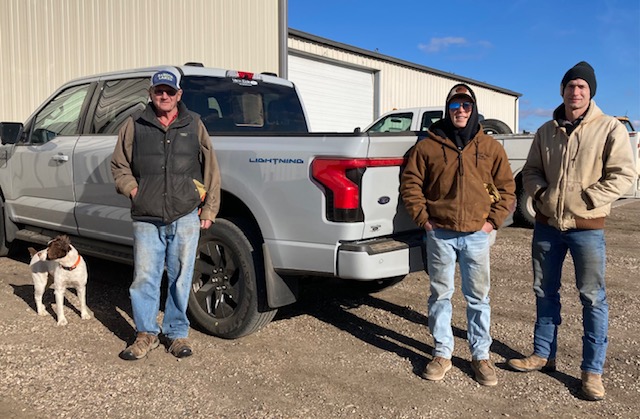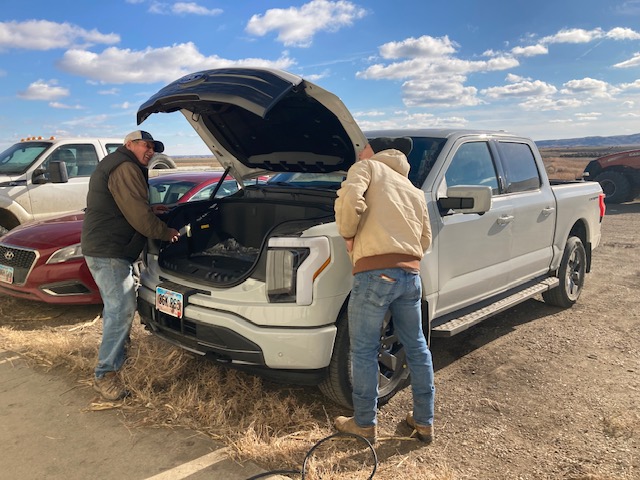Becoming fossil fuel neutral
Friday, December 15, 2023

At Dakota Lakes Research Farm, Dwayne Beck (left), Sam Ireland (center) and Cody Zilverberg (right) show off the new Ford Lightning electric pickup that was recently delivered. It's just one piece of their overarching strategy to become fossil fuel neutral.
By Dwayne L. Beck, former Dakota Lakes Research Farm Manager
Nationwide fossil fuel costs are involved in approximately 80% of variable costs associated with crop production. Fossil fuel costs have accelerated in recent years and will continue to increase as supplies tighten and regulations on its use increase. This input will continue to threaten profitability in the future.
Dakota Lakes Research Farm Corporation (DLRF) has made the strategic goal of being FOSSIL FUEL NEUTRAL by 2026. This is not a zero-carbon goal, or zero-net-carbon goal, etc. It is important to know the definition of all the different approaches being proposed. Fossil fuel neutral means DLRF will produce energy equivalent to the fossil fuel presently being used. Here’s the short-term plan as well as longer-term ideas.
- Directly reduce fossil fuel use. An all electric Ford pickup was purchased to reduce fossil fuel needs. Similarly, one electric side-by-side was built. Plans call for adding an electric car and more electric UTV’s. Our zero-net-energy shop and office facility uses about 40% of the energy that would be required if it were still traditionally insulated, lighted, or heated/cooled. The remaining energy requirement is purchased from the local electric cooperative. Much of their energy is presently generated using fossil fuel. Our goal will be to generate much of this energy on-site (solar) or to produce bioenergy in the form of SVO (straight vegetable oil) that can be used to offset this use. SVO can also run generator sets to make replacement power. DLRF presently uses about 5,000 gallons of field diesel, 2,000 gallons of road diesel, and less than 1,000 gallons of gasoline per year. One acre of sunflowers yielding 2,000 lbs/ac produces well over 100 gallons of SVO (700 lbs. of oil This means that less than 100 acres (100 acres X 100 gallons/acre=10,000 gallons) of sunflowers produced for oil would be needed to replace or offset the DLRF direct fuel needs. The meal produced as a byproduct of pressing oilseed would still be available to use as livestock feed.
- Introduce solar power. A 50 kW solar array being installed at DLRF will be capable of producing sufficient energy to meet the needs of the building complex. A 25 kW second array will be used to meet the demands of the grain bins. Energy storage strategies will need to be developed. The heated concrete floor on the main shop at DLRF is a “battery” in that it can be warmed during periods when there is sunlight and not heated at night. There will be a battery in the Ford Lightning pickup that could serve as backup power for the basic office functions necessary at night. An alternate battery system might also be employed.
- Develop uses for excess energy. The main building array will be 50 kW. There are times during the year when this will be more than needed, especially in the spring and fall when air conditioning and heating demands are low. Fall is the time when demand for grain bin aeration is high. It is also high at times in the spring as stored grain needs to be warmed. The separate 25 kW array specifically associated with the grain bins might not be sufficient. There are many times of the year when there is little electrical use. The plan with both arrays is to develop beneficial uses for the excess energy when it is available. The first thing that comes to mind is to produce hydrogen gas (and oxygen gas) by electrolysis of water. The hydrogen gas could be used in a fuel cell to make electricity. This is in essence a battery. There is substantial work being done to use fuel cells to operate electric-powered field equipment like combines. The benefit would be much lower operating temperatures of electric motors as compared to internal combustion engines.
- Reduce reliance on N produced by the Haber-Bosch technique. Hydrogen could also be used to manufacture nitrogen fertilizer. There is a company (Exactrix) that is developing and selling this technology. The energy equivalent of the nitrogen fertilizer used at DLRF is slightly greater than the amount of liquid fuels used each year. This and the amount of energy used in pumping irrigation water are both substantial challenges to be solved. Stored hydrogen or stored aqua ammonia could both be considered batteries. Hydrogen can be used to run diesel engines (Cummins is doing this now) that power a generator set. It is not likely to be used for in-field operations because storage tanks need to be large. The SVO produced on the farm could also be used to power generator sets and to run equipment when that is approved. The Cummins technology is designed to be used along with hydrocarbon fuel. They are marketing fuel agnostic engines for generators that can burn a variety of fuel from hydrogen to SVO to biogas. One hundred years ago, farmers raised feed for their powerplants (draft animals) and used wind-powered generators. Back to the future.
The bottom line is that the transition to being neutral relative to the use of fossil fuel is well on the way. There will be a need to use fossil fuel-based oils for lubrication and such for some time. These uses will be offset by producing cold-pressed oils. Electricity use will be offset by producing much of the present electricity use. This is not being “off-grid.” It is just setting up to be substantially less dependent on fossil fuel sources because these will continue to become less available and more costly. More of the nutrients contained in the crops will be cycled rather than exported. All of this will help to make the system more cyclic and less linear.

Since there's no combustion engine in the Ford Lightning, the area under the hood is called the "frunk." It features 14.1 cubic square feet of storage space as well as several power outlets that can be used while driving or parked. Here, Dwayne and Cody check out the system, which offers 2,400 watts or six amps across all six outlets.
Categories: News